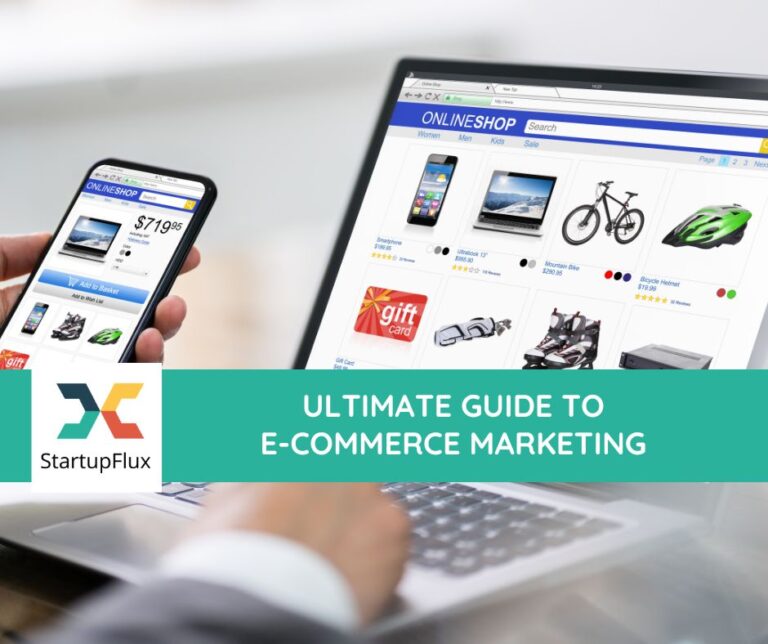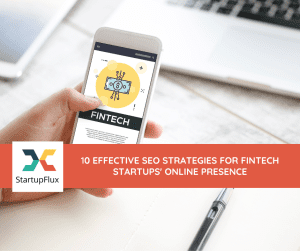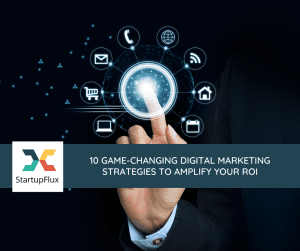Worldwide retail e-commerce sales are projected to climb up to $6.3 trillion in just a few years – this has encouraged businesses all over the globe to lean into digital selling tools and platforms as part of their strategies. We hope this post gives everyone a better understanding of e-commerce marketing. It covers useful stuff like the benefits when it should be used, and ways to maximize strengths while avoiding weaknesses for managing & growing your business.
What is E-Commerce Marketing?
E-Commerce Marketing really is all about boosting your business’s visibility and getting people to take action. It’s when you get people to purchase products or services electronically. It involves the employment of marketing strategies to drive traffic to your online store, persuading customers to buy products/services that are sold online, converting consumers into paying clients, and keeping those ties going after the sale. To get more visitors or traffic on your e-commerce site, you need to consider SEO. Plus, you should look into leveraging other marketing channels, including email marketing, social media marketing, paid advertising, and affiliate marketing.
Read about : Characteristics Of A Scalable Business
What is E-Commerce Advertising?
E-commerce ads are an amazingly effective way to reach more potential customers and boost sales. By combining it with E-commerce marketing, you can create more opportunities for yourself as well as increase brand recognition. Trust us when we say that it’s an awesome way to get your products and services out there!
For those selling their products online, then e-commerce advertising is a great tool to get the word out. You can use display ads, rich media ads, and banner ads to reach the right people and effectively promote your offerings.
E-Commerce Marketing Vs E-Commerce Advertising
E-Commerce Marketing and Advertising go hand in hand, but they’re two distinct concepts. Essentially, marketing helps establish and strengthen your brand, while advertising is all about promoting it. And E-Commerce marketing is like diving into a market research adventure, while E-Commerce advertising takes that knowledge and turns it into an epic action.
E-Commerce marketing is like a mastermind, requiring clever strategizing and planning. Whereas E-Commerce advertising is like a tactical genius, taking action to bring in those conversions.
To top it all off, E-Commerce marketing is understanding how people think and act, while E-Commerce advertising is what actually helps to make sales.
So, yeah, they may be similar in some ways, but these differences make E-Commerce Marketing and Advertising a power duo in the online business world.
E-Commerce Marketing Examples
Check out some of the following E-Commerce Marketing examples:
- Brand introduction video -A brand intro video is a rad way to spread the word about your business and create connections with potential customers.
- Customer referral program – Got a lot of loyal customers? With a customer referral program, you can reward existing customers for referring new ones – it’s an effective e-commerce marketing technique.
- Email with a product bundle discount – Emails are an amazing way for businesses to promote their products & discounts. You can use them to create bundle deals which makes them cost-effective and also very useful for sending marketing messages.
- Blog article about how to use the product – Create blogs to tell your audience how to use a particular product as a way to reach more people and boost engagement, making it the perfect method to get the word out there about your business.
- Social media posts with videos featuring influencers – Influencers have proven to be really useful in increasing public awareness and sales of your brand/products by posting videos.
The E-Commerce Marketing Funnel
The E-Commerce Marketing Funnel is made up of 4 distinct stages-
- Awareness Stage: You might’ve heard of people talking about your brand but haven’t bought anything yet. This is the awareness stage of this funnel, which is when you can introduce your products & services and gain their trust.
- Interest Stage: During this part of the marketing funnel, customers know that you can provide them with the product or service they need.
- Purchase Stage: When customers get to the purchase stage, they already know how your product or service solves their issue. All that’s left for them to do is hit the checkout button – a bit of help in that department can go such a long way.
- Repeat Stage: Once customers have bought something from your e-commerce store, the last thing to do is ensure they stay satisfied. Offer them rewards, loyalty points, and great service – anything (and almost everything) that will make them feel appreciated and valued.
What are the main 4 types of eCommerce business models?
Here are the four types of e-commerce business models:
- Business to Consumer (B2C): This model is when businesses sell their products/services directly to regular consumers like you and me. It’s like when online stores or companies cut out the middleman and bring their awesome stuff straight to our doorsteps.
- Business to Business (B2B): Now, this is where businesses sell their products/services to other businesses. It’s all about companies helping each other out, like when big players connect with other businesses to meet their needs.
- Consumer to Consumer (C2C): This type of eCommerce is all about regular people selling things to other regular people. It could be old stuff or even brand-new items. Do you know those popular platforms like eBay where you can buy and sell directly to fellow consumers? That’s the C2C scene.
- Consumer to Business (C2B): Now it’s time for consumers to take the lead! In this model, individuals with specific skills or talents offer their services to businesses. Platforms like Upwork, Fiverr, and Maypole are examples where freelancers shine and provide their expertise to companies in need.
Read about : advantages of customer segmentation
Types of E-Commerce Marketing
E-commerce marketers have a bunch of awesome platforms in their arsenal to connect with new users and keep their existing connections strong. Picking the right types of E-commerce marketing can make a real splash. Here are some of the main ones you gotta know:
- Text Message (SMS) Marketing: This one’s super engaging! Did you know that about 58.7% of text messages get a response within five minutes? You can use SMS marketing in cool ways, like automating shipping notifications, sending referral rewards or loyalty program updates through texts, and even blasting out promos and discount codes right to people’s phones.
- Influencer Marketing: When it comes to marketing in this day and age, this type is the bomb. Influencers have serious sway over people’s purchasing decisions, with around 49% of consumers relying on their advice. You can use services like Klear or Heepsy to find the perfect influencers for your target audience. Get them to create awesome content for your website and product pages and boost your brand’s awareness.
- Conversion Rate Optimization (CRO): CRO is like the secret sauce for E-commerce marketing success. It’s all about making your checkout process smooth and optimized, running A/B tests to fine-tune your strategies, using smart popups or offers to keep customers hooked, collecting user data to improve the overall shopping experience, and getting the most out of your traffic sources. Imagine paying for Instagram ads. By optimizing your checkout process, you’ll turn more of those Instagram peeps into actual buyers.
- Email Marketing:
Email marketing is like the king of marketing channels in the E-commerce world. With emails, you can unleash a variety of strategies tailored to specific contexts and target demographics. It’s all about staying connected and keeping your customers in the loop with updates, deals, and exclusive offers.
Let’s dive into some awesome email tactics:
- Abandoned Cart Emails: These gems target users who left items in their cart but didn’t complete the purchase. It’s like a friendly reminder to come back and seal the deal.
- Promotional Emails: Time to spread the word! These emails inform your subscribers about new or existing items or services, creating buzz around exclusive offers and limited-time deals. Who can resist a holiday special or a discount sale?
- Behavioral Segmentation Emails: Let’s get personal! By sending specific emails based on how users behave on your website, like what items they’re browsing, you can tailor the content to their interests and preferences.
- Product Upsells and Cross-sells Emails: Upgrade time! Upsell emails invite users to level up their subscriptions, while cross-sell emails leverage sales opportunities to offer more products or services to existing customers.
- Referral Marketing and Customer Loyalty Campaigns: Referral marketing emails incentivize your existing customers to spread the word about your company, while customer loyalty campaigns shower your loyalty program members with exclusive rewards.
- Welcome Flow Emails: First impressions matter! These emails are your chance to confirm a new registration, make a subscriber feel welcome aboard, and set the stage for a fantastic relationship.
- Shipping and Delivery Notifications Emails: Keep them informed! These emails update users about the status of their purchases, keeping them interested and excited about the impending arrival of their goodies.
- Email Newsletter Campaigns: It’s time for a big blast! Newsletter campaigns are those emails sent to a large number of people at once. The goal? Persuade recipients to buy a product, learn more about your company, or simply stay in the loop.
Now, let’s spice up those emails with some killer elements to test:
- Customer testimonials, success stories, and product reviews: Give your brand more credibility by including positive reviews and success stories from happy customers.
- User-Generated Content (UGC): Share the love! Use content created by unpaid contributors, like customers, to make your emails more authentic and engaging.
- Popular social media posts: Boost engagement by featuring popular posts from your social media accounts. It’s an incredibly great way to showcase your brand’s personality and capture attention.
- Individual product and product categories: Provide users with more information about specific products or categories to pique their interest & increase the chances of a purchase.
- Influencer images and videos: Tap into the power of influencers! Use their images and videos to sway customer decisions, especially when you choose the right ones for your target audience.
- PR testimonials and reviews: Showcasing testimonials and reviews from people who received PR packages can be influential in nudging customers toward making a purchase.
Top 6 Digital Marketing Strategies –
Now, let’s explore some other digital marketing strategies to amplify your ROI:
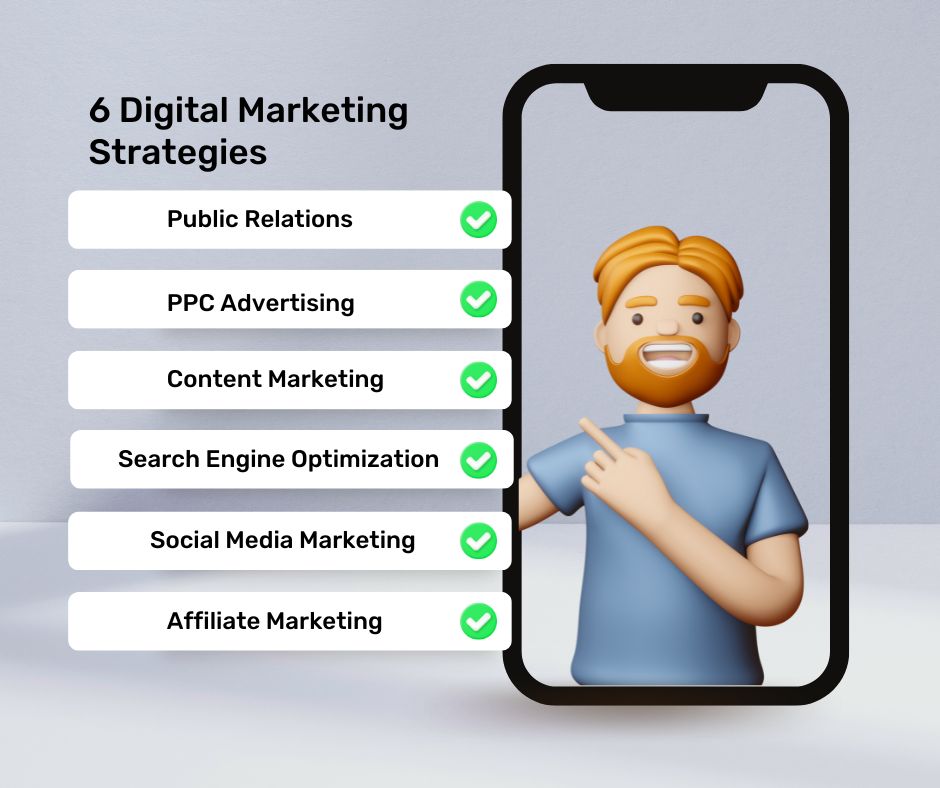
1. PPC Advertising:
Get ready to pay for clicks! PPC advertising is a popular approach where you pay publishers when users click on your ads. Facebook is a prime platform with a massive audience (2.14 billion people) and impressive ROI. Stats reveal that Facebook users click on 12 advertisements every month. So, it’s a smart choice to focus your advertising budget on Facebook.
2. Content Marketing:
Content marketing uses relevant articles, videos, podcasts, and more to attract, engage, and retain an audience. Here are some content marketing techniques to try:
- E-Commerce Gift Guides: Drive sales with the magic of gift guides. They work wonders for showcasing your products and inspiring shoppers.
- Long-form Blog Posts: Go deep! Provide detailed information about your products/services through informative long-form blog posts.
- Customer Testimonials: Allow your customers to do the talking. Share their testimonials to convince potential buyers that your brand is the real deal.
- Video Content: Capture potential customers’ interest with engaging video content that showcases your products or tells your brand’s story.
- Company News: Keep your audience updated with exciting company news. It’s a way to showcase your growth and development.
3. Search Engine Optimization:
SEO revolves around fine-tuning your website to boost its presence and drive more visitors from search engines. Here are the fundamental parts of a go-getting SEO plan:
- On-Page SEO: Optimize elements on your website like content, keywords, meta tags, headers, page titles, link building, URLs, and image optimization to rank higher in search engine results.
- Off-Page SEO: Get your website out there with methods like backlinking, content marketing, social media marketing, podcasting, influencer outreach & local business listings. It’ll put you ahead of the competition and help improve your ranking.
- Technical SEO: You need to make sure your website is working optimally from a technical standpoint. You can do this by looking at stuff like page & site loading times, how it’s organized, making sure search engines easily access all the pages, getting an SSL cert for security purposes, and making sure it’s mobile compatible. It’s about creating a smooth user experience while impressing search engines.
4. Social Media Marketing
Social media is an unbelievably invaluable tool for any e-commerce biz. It lets you build relationships with customers, engage with audiences and drive more traffic & sales to your site. For e-commerce stores, Instagram and Pinterest are the top options because they’re very visual and give you access to people with a higher likelihood of making purchases.
Now, let’s dive into some fantastic social media marketing tips that will take your brand to new heights:
- Content Repurposing: Don’t let your amazing blog content go to waste! Repurpose it for social media to increase leads and drive more traffic. It’s like giving your content a second life, and trust me, it works like magic.
- Trendy Updates: Show the world that your business is on top of its game! Try sharing posts about the latest market trends, and let your audience know that you’re not just following trends—you’re setting them. Stay ahead of the curve, my friend!
- Expert Recommendations: Be the go-to guru in your niche. Offer informed product recommendations and easy-to-follow advice to your customers. They’ll appreciate your expertise and keep coming back for more.
5. Affiliate Marketing
Picture this: You team up with external websites, and every time they send referral traffic or make a sale for your online store, you give them a sweet commission. That’s affiliate marketing! It’s like building an army of brand advocates who’ll bring in more customers. Whether you create your own affiliate program or join established networks like Referral Candy, PepperJam, Share-a-sale, Rakuten, or Refersion, get ready to monetize those collaborations and watch your profits soar.
Read about: asset utilization calculation
6. Public Relations
Public relations or PR takes your brand to the big leagues by getting your content published on major publisher websites. It’s like diving into a pool filled with exposure and reaching a massive pre-existing audience. Yes, it may be a bit costly, but when done right, it’s a surefire way to supercharge your consumer base and achieve tremendous growth.
E-Commerce Marketing Tips
We’ve curated some of the most effective tips that you can implement below –
1. Personalization
Personalization in e-commerce can make your online store stand out from the competition & make it more attractive to potential customers. Studies also show that businesses that customize their offerings can expect to see an increase in revenue of 6-10%. To best reach individuals, consider customizing your marketing messages to each customer’s needs. This personalization process can help them move quickly through the buyer’s journey and potentially form a stronger connection with your brand.
2. Capitalize on User-Generated Content –
Embracing user-generated content not only drives traffic to your e-commerce store but it also builds a loyal following for your brand. Here’s how you can unleash the power of UGC:
- Build a Loyalty Program: Entice customers to keep doing business with you by offering relevant incentives and discounts. Let them showcase their loyalty through repeat purchases, social media mentions, or content sharing. Show them the love!
- Word-of-Mouth Marketing (WOMM): Word-of-mouth is gold! People trust recommendations from people who are just like them. So, encourage your satisfied customers to spread the word about your brand. Let them become your brand ambassadors, and watch the magic happen!
- Reviews: Ah, the power of reviews! They not only provide references for your product but also act as incredible marketing tools. Allow your customers to do the selling part for you by sharing their positive experiences.
- Referral Marketing: It’s like a domino effect of sales! Encourage your customers to refer their friends, family, and coworkers to your store. In return, offer them a valuable item. Everyone wins, and your brand reaches new horizons.
- Testimonials: People love hearing success stories. Use testimonials to convince potential customers that your product works like a charm. When they see others achieving greatness with your offering, they’ll want a piece of the action too.
- Case Studies: Showcase your clients’ triumphs in captivating case studies. Paint a picture of success that entices prospects to buy. Show them what’s possible, and they’ll be eager to join the winning team.
- Live Chat Magic: Let’s bring a personal touch to the shopping experience! If you can swing it, invest in live chat. Having a live person to interact with potential customers while they browse your store enhances their experience. I
- Crushing Shopping Cart Abandonment: Don’t let those pesky abandoned carts ruin the party! Address your customers’ objections head-on. Offer money-back guarantees, a clear and simple return policy, great delivery options, and immediate access to customer support. Give them every reason to hit that “Buy Now” button.
- Responsive Website Design: In a fast-paced world where consumers are always on the move, your content must shine on all devices and platforms. Do make sure that your website is easy to navigate and read for users, whether they’re on a laptop, smartphone, or tablet.
E-Commerce Marketing Strategies
Not sure how or where to get started on your e-commerce journey? Check out these e-commerce strategies for guidance!
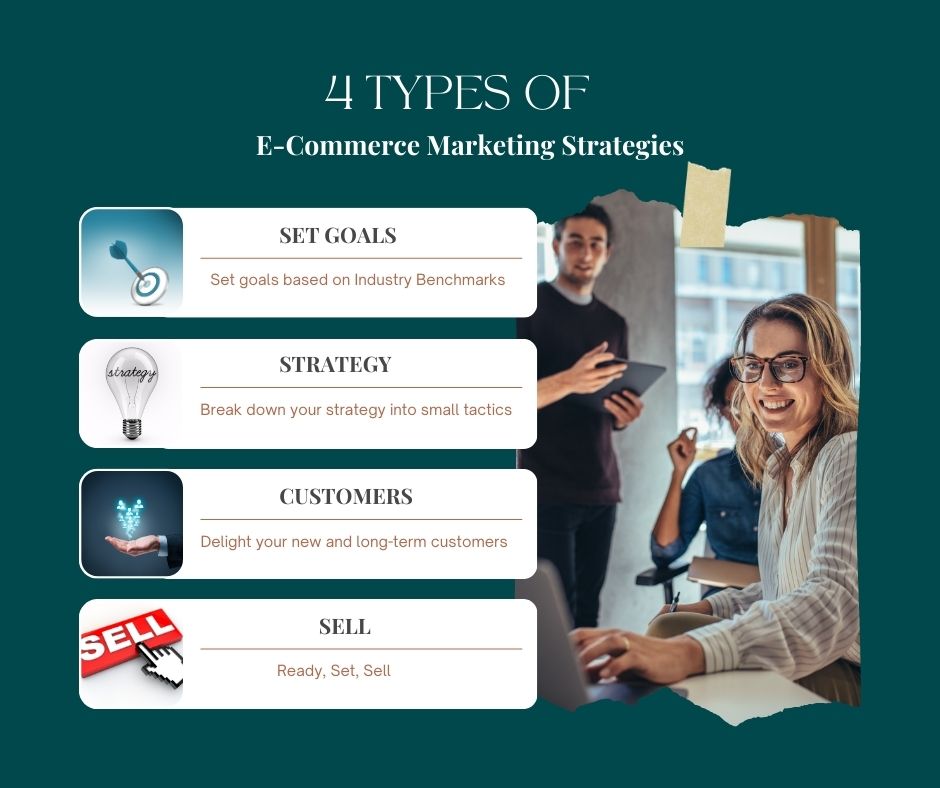
- Set goals based on Industry Benchmarks: When you have industry benchmarks as your guide, it’s easier to measure your success. Working with these objectives can help you achieve more. Comparing website views, click-throughs, conversions and customer acquisition expenses with others in the same field can give you a brilliant idea of where you stand.
- Break down your strategy into small tactics: Crafting a marketing plan for your e-commerce store involves trying out different methods. Our advice is to start with a few key tactics that have the best potential and are doable and then work out steps that you’ll be taking for each.
- Delight your new and long-term customers: Make your customers happy – long-term and new. Help them with their goals and you will create a group of loyal followers who appreciate what you do and are more likely to spread the word.
- Ready, Set, Sell – E-commerce businesses have plenty of marketing strategies they can use. Going digital and utilizing inbound methods can be great ways to create campaigns that will draw customers to your online store and help it grow.
Most Popular E-Commerce Marketing Platforms
Did you know that Amazon is the ultimate starting point for a whopping 74% of product searches by savvy US consumers? Talk about the go-to place for finding all the cool stuff! And get this, 56% of these shoppers would totally dig buying everything from just one store, and guess which store they have in mind? Yep, you guessed it—Amazon! So, if you’re selling your awesome e-commerce products, you definitely want to consider hopping on the online marketplace bandwagon, whether it’s Amazon or even Walmart. Trust us, it comes with some sweet perks. These platforms are practically the hangout spots for a massive crowd of internet users. Plus, they’ve got those media big shots throwing stacks of cash into affiliate marketing and paid search. They’re all about making noise and getting your products noticed.
Most Popular eCommerce Marketing Platforms
- Shopify: Shopify stands out as one of the more user-friendly options and helps merchants set up their own online stores with ease. It offers a wide range of features & has the largest selection of third-party apps and plugins to enhance store functionality.
- BigCommerce: BigCommerce is a robust platform suited for more advanced users. It provides advanced functionality and customization options to create a tailored eCommerce experience.
- Klaviyo: Klaviyo is a highly popular email marketing tool specifically designed for eCommerce brands. It offers powerful automation and segmentation features to help businesses drive customer engagement and sales.
Most Popular eCommerce Online Marketplaces
- Amazon: Amazon is the largest online marketplace, boasting over 350 million products. It offers a comprehensive advertising platform that allows sellers to reach a vast customer base.
- eBay: As the second largest eCommerce platform in the United States, eBay is a popular choice for sellers. It is particularly suitable for tech gadgets, fitness equipment, jewelry, and pet supplies.
- Walmart: Walmart’s eCommerce platform has been booming – 60% more popular than the year before. US and Canadian businesses can really benefit from this as they could get access to a massive customer base.
- Etsy: Etsy is a thriving online marketplace known for its focus on arts, crafts, and handmade goods. It provides a platform for creative individuals and artisans to sell their unique products.
- Houzz: Houzz is an excellent platform specifically tailored for home decor products. It serves as a hub for homeowners, designers, and sellers to connect and discover inspiration for their interior design needs.
